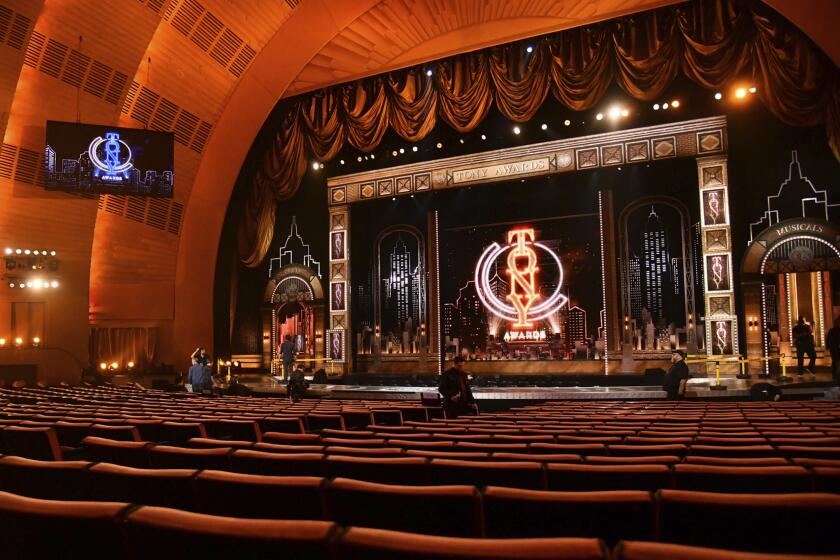An ‘Ocean’ of Movement : Merce Cunningham Company Creates Waves of Light and Sound
- Share via
BERKELEY — On a 44-foot circle in the center of Harmon Gym, members of the Merce Cunningham Dance Company form sculptural clusters projected to all points of the compass: choreography designed with no “front,” no single ideal viewing position.
Lighted from every side, they dance underneath an enormous circular net canopy that often glows with intense color as light passes through it and creates patterns of diffusion high above their heads. This diffusion, along with their gleaming Marsha Skinner unitards and the way they constantly dart in and out of the circle, helps evoke the underwater ambience that is the work’s unifying metaphor. It’s not called “Ocean” for nothing.
Surrounding the dancers on wooden bleachers: an audience that sometimes becomes part of the undersea environment when bathed in rich turquoise and other Skinner lighting effects. And surrounding the audience: a 112-piece orchestra spread out along the very top of the bleachers to play a score (more accurately, five scores going on at the same time) originally envisioned by John Cage and realized after his death by his longtime associate Andrew Culver.
As if that score weren’t complicated enough, electronic music by David Tudor streams from loudspeakers high above the dancing--sometimes incorporating recordings of marine life (barking seals, for example), but more often adding a wash of generalized environmental sound to the instrumental surges provided by the musicians.
Near one of the TV monitors that digitally count every millisecond of the 90-minute piece sits Cunningham himself, who originally planned to produce “Ocean” five years ago in Zurich but found conditions unacceptable and moved the premiere to Brussels three years later. Cal Performances at UC Berkeley brought the work to America for the first time Friday, with Lincoln Center also scheduled to present it in late July. There are no plans for the work to be given in Southern California.
A pity, since “Ocean” obviously represents one of the great modernist dance spectacles of the age, one teeming with compositional complexities laboriously detailed in the program notes. Happily, you don’t have to be able to count Culver’s “32,067 [musical] events spread over 2,403 pages” to connect with the work’s accessible game plans. One, for example, involves changes of costume color: an evolution from lavender unitards that fade to a silvery gray across the chest and arms to a display of solid, deep-purple dance wear at the end. In between these extremes come random combinations of blue, black and green plus the high intensity of coral that makes some dancers appear to glow in the dark.
Another gambit is numerical: the very gradual buildup of dancers from Frederic Gafner’s solo two minutes into the piece until all 15 dancers are at last together just two minutes before the end. Much of the time, Cunningham choreographs in sixes--often three couples--with the dancers deployed on the rim of the circle. This layout gives every viewer dancers to watch in the foreground and also a kind of reflection or shadow of their movement on the far side of the circle.
Arms reaching up and out form a key movement motif, just like the weightless balances in extension and all the high-velocity entrances and exits that enhance the sense of tiny bodies hurtling through a huge empty space. Leisurely duets periodically suggest human relationships, but more often the dancers arrange themselves into sharp-angled reefs or pass into the circle as if borne by powerful currents.
Above all, the strategies and beauties of “Ocean” are inseparable from its scale: these colors and these stretched limbs in this much space; these sounds floating down to us from this far away. Whatever else it accomplishes, this final Cage-Cunningham collaboration offers the kind of live performance that can’t be reproduced technologically without diminishing it. Record it and you’ll never hear all the places the music comes from--or bounces against. Film it and you’ll get only the dancing--the fish and not the ocean.
At 77, Cunningham still sees dance as something wondrous and makes us see it that way too by conjuring up an oceanic void in which every color, every horn call, every individual motion becomes a cherishable event: an affirmation of life in the midst of emptiness and of art deep within that life.
More to Read
The biggest entertainment stories
Get our big stories about Hollywood, film, television, music, arts, culture and more right in your inbox as soon as they publish.
You may occasionally receive promotional content from the Los Angeles Times.










